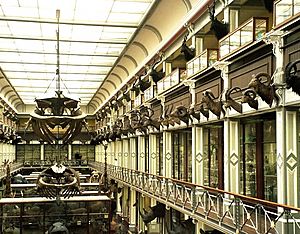Frederick Clarendon facts for kids
Quick facts for kids
Frederick Villiers Clarendon
|
|
|---|---|

Inside the Natural History Museum in Ireland
|
|
| Born | C. 1820 Dublin, Ireland
|
| Died | 1904 Dublin
|
| Nationality | Irish |
| Alma mater | Trinity College, Dublin |
| Occupation | Architect |
| Practice | Board of Public Works |
| Buildings | National History Museum, Dublin |
Frederick Villiers Clarendon (born around 1820, died 1904) was a talented Irish architect. He is famous for designing many important public buildings in Dublin, Ireland. Some of his well-known projects include the Natural History Museum and Arbour Hill Prison.
Contents
Life of Frederick Clarendon
Frederick Clarendon was born in Dublin, Ireland, around the year 1820. He went to Dublin University and earned a Bachelor of Arts degree in 1839. Right after finishing college, he started working for the Office of Public Works. He worked there for a very long time, until he retired in 1887. Clarendon passed away in 1904 in Mountjoy Square, Dublin.
Clarendon's Architectural Works
Frederick Clarendon worked on many interesting buildings throughout his career. His earliest big projects focused on Dublin's prison system.
Designing Prisons
In 1845, Clarendon helped redesign Arbour Hill Prison. He worked as the main architect for this project, which was led by Sir Joshua Jebb. Two years later, he also helped design a special hospital for people with mental health issues in Dundrum.
Royal Irish Academy Renovation
Between 1852 and 1854, Clarendon oversaw a major renovation. He worked on the Royal Irish Academy's building on Dawson Street. The Academy needed more space because their old location on Grafton Street was too crowded.
The Natural History Museum
Clarendon's most famous work is the Natural History Museum in Ireland. It is located on Merrion Street next to Leinster House. People sometimes call it the "Dead Zoo" because it displays many preserved animals. The Royal Dublin Society needed a public architect to get money from the government for the building. The Irish government took over the museum in 1877. Today, it is part of the National Museum of Ireland.
Mariners Hall in Howth
In 1867, Clarendon designed the Mariners Hall in Howth without charging any fees. This building was used as a church for over 30 years. Services there were held in Scottish Gaelic, the language of the fishermen who came to the village for seasonal work.
Images for kids
See also
- Architecture of Ireland


